Community Environment Government Transportation
Gig Harbor plans $2 million roundabout at 56th Street and 38th Avenue
Many people living near the junction of 56th Street NW and 38th Avenue NW, at the western edge of Gig Harbor city limits, have been there long enough to remember when it was a country crossroads.
Traffic at this spot is not bad now. But when city officials look at the intersection in light of the surrounding area’s likely future growth, the picture is not pretty.
They foresee cars and trucks idling through multiple red-yellow-green stoplight cycles and frustrated drivers jockeying to get into their desired lanes. That kind of mess is already the rush hour status quo at crossings a short distance to the east, near Highway 16.
To head off future congestion, the city plans a big solution: A new roundabout at 56th and 38th to replace the existing signaled intersection.
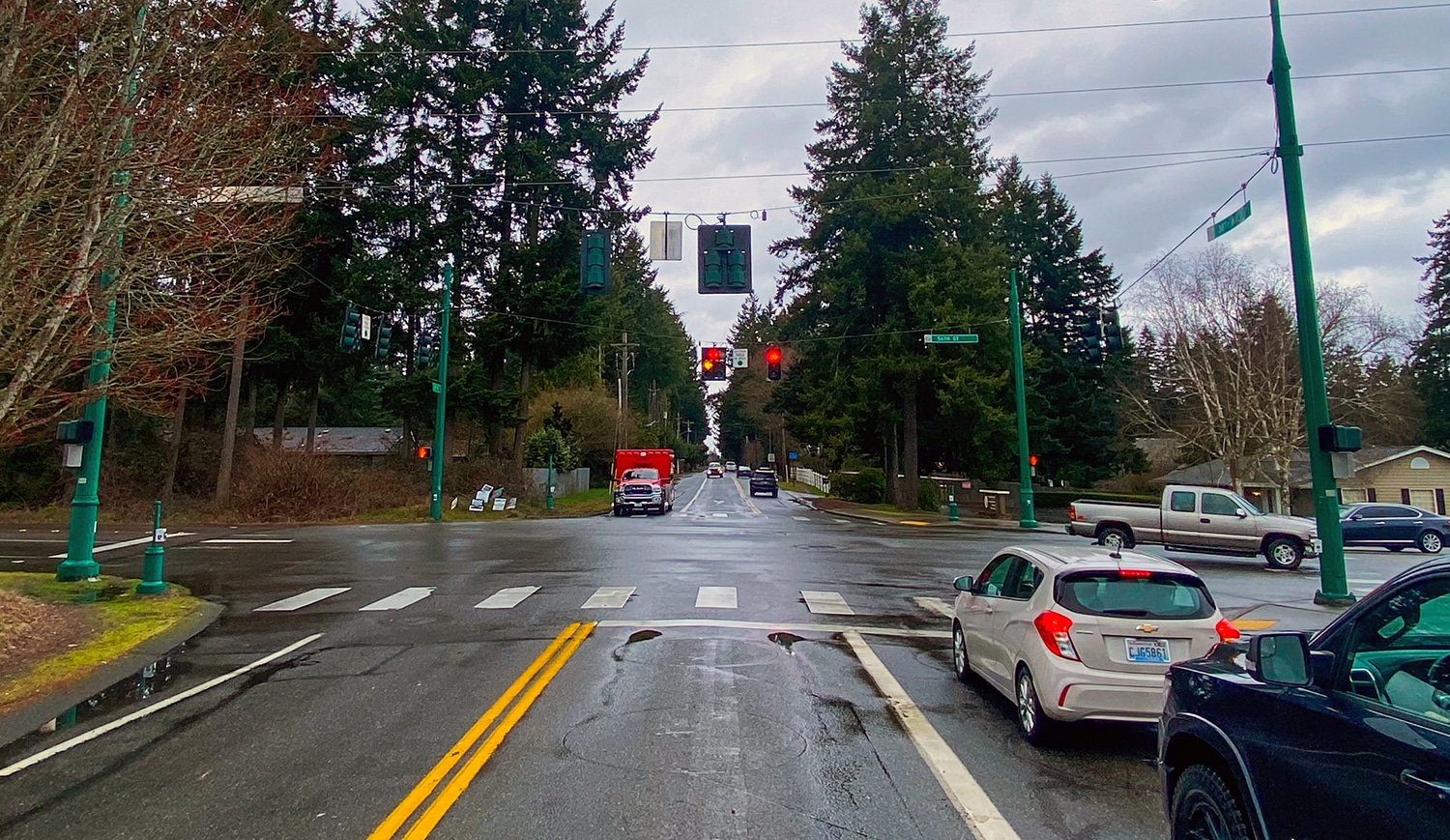
The city of Gig Harbor plans to build a roundabout to handle traffic at the intersection of 38th Avenue and 56th Street. This view shows 38th looking north across 56th. Photo by Ted Kenney
A $2 million project, with savings down the road
The proposed roundabout would cost approximately $2 million. The alternative — which is to revamp the signaled intersection to achieve Americans with Disabilities Act (ADA) compliance — would cost an estimated $1.18 million. The city has been upgrading the 38th Avenue corridor between Hunt Street and 56th Street, and meeting ADA codes at the intersection is a mandatory part of the project, said Aaron Hulst, the city’s traffic engineer.
Hulst noted that the money outlays between the two alternatives could be “a wash.” While roundabouts are more expensive up front, their ongoing costs are lower than signaled intersections. The city likely will apply for a grant from the state’s Transportation Improvement Board to help cover the roundabout’s construction, he said.
The proposed roundabout will take up more land than a signaled crossing, and this presents another challenge. To follow through with their plan, the city needs to obtain right-of-way from property owners on all four corners of the intersection, either via easement or outright land purchase – and some of these owners say they don’t want to sell.
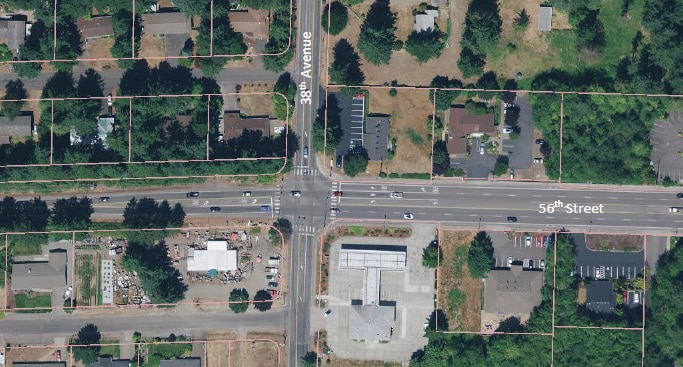
City officials predict substantial growth and increased traffic in the area of the intersection of 56th Street and 38th Avenue.
Gig Harbor has not yet reached out to the landowners about the roundabout. But home and business owners around 56th and 38th heard about discussion of the proposed roundabout at city council meetings and in other venues in recent months.
Neighbors want to pump the brakes
“At this time, we will not be providing right-of-way for the roundabout proposal,” said Matt Cyr, a member of the Stroh family that owns the land at the southwest corner of the intersection, and who also lives nearby. The property is well-known as the former site of Patterson’s Market, a produce stand and country store for 43 years whose tenancy was terminated last year.
Family members believe the project would negatively affect traffic in adjacent areas, Cyr said. He said that unrestricted flow of vehicles on 38th and 56th (as would happen with a roundabout) would impair access from nearby properties. Locals would have difficulty turning from residential streets onto the arterials at times of heavy traffic.
Access and advertising
Tony and Anna Colombini, who own the property on the northeast corner of 56th and 38th, have similar concerns. Anna Colombini, a naturopath, has run her clinic, Peninsula Natural Health Center, there since 2014. The couple purchased the real estate in 2020.
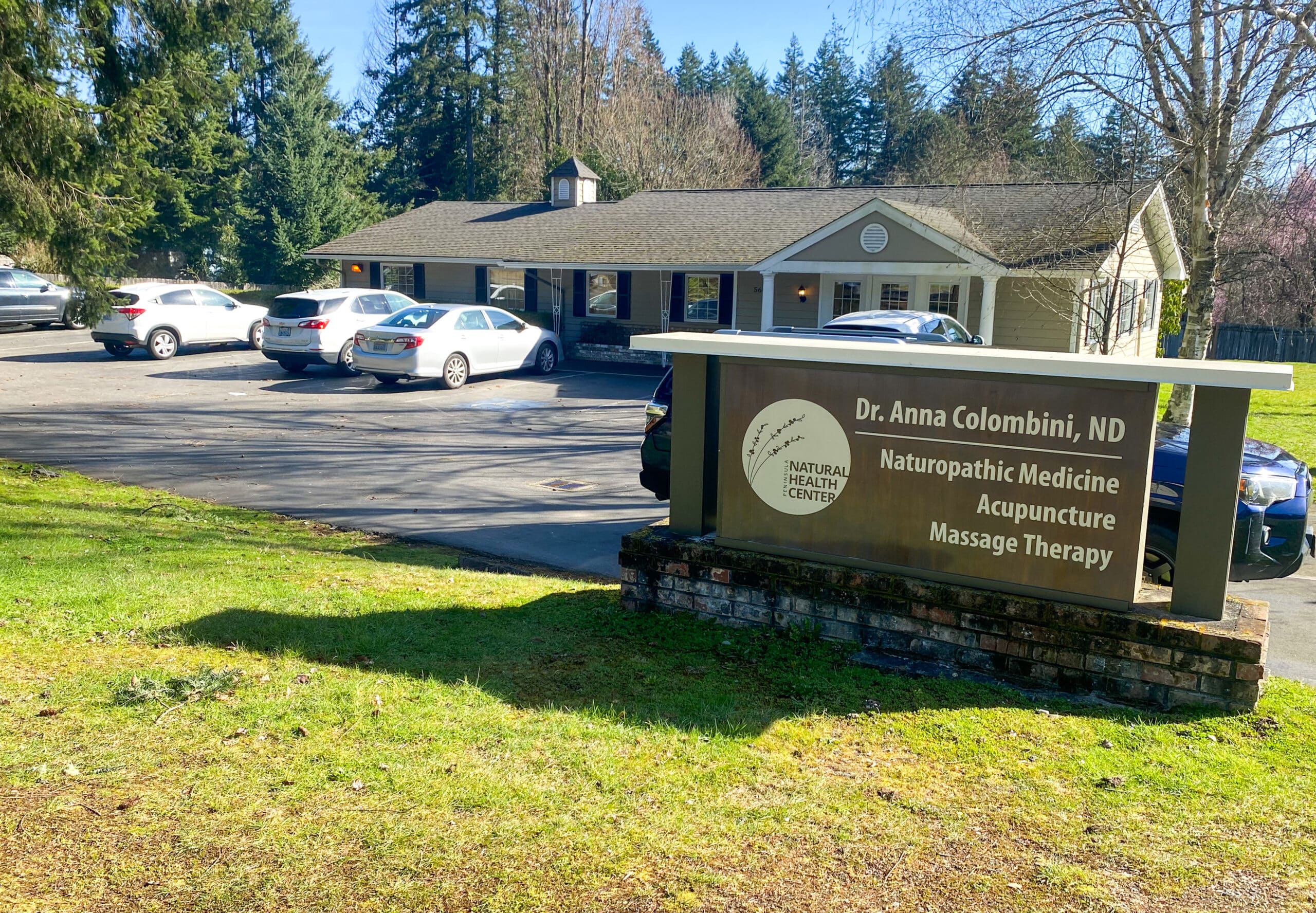
The Colombinis, who own this business and property on the corner of 56th and 38th, worry about access to their establishment and the fate of this sign if the city builds a roundabout there. Photo by Ted Kenney
They worry about the proposed roundabout’s effect on their safety and ease of access. The only way into and out of their parking lot is via a driveway that feeds onto 38th Avenue a short distance from the intersection. Some westbound drivers making right turns onto 38th already go too fast, they said, posing a hazard to vehicles pulling out of their parking lot.
Without a red light intermittently stopping these cars, the Colombinis worry they will see a non-stop flow of vehicles going even faster. Will they have to bar left turns from their driveway, creating a major inconvenience for patients and employees heading to the freeway and to points south, including Tacoma?
In addition, a preliminary conceptual diagram of the planned roundabout and its associated sidewalks and crosswalks shows the outer edges cutting across the corner of the Colombinis’ land and likely eliminating the clinic’s sign. If the city takes the corner of their property, finding a new place for the sign that is as visible as the current location would be a “huge” challenge, in part because of the city’s setback requirements, Tony Colombini said. “I don’t know where we’d relocate it.”
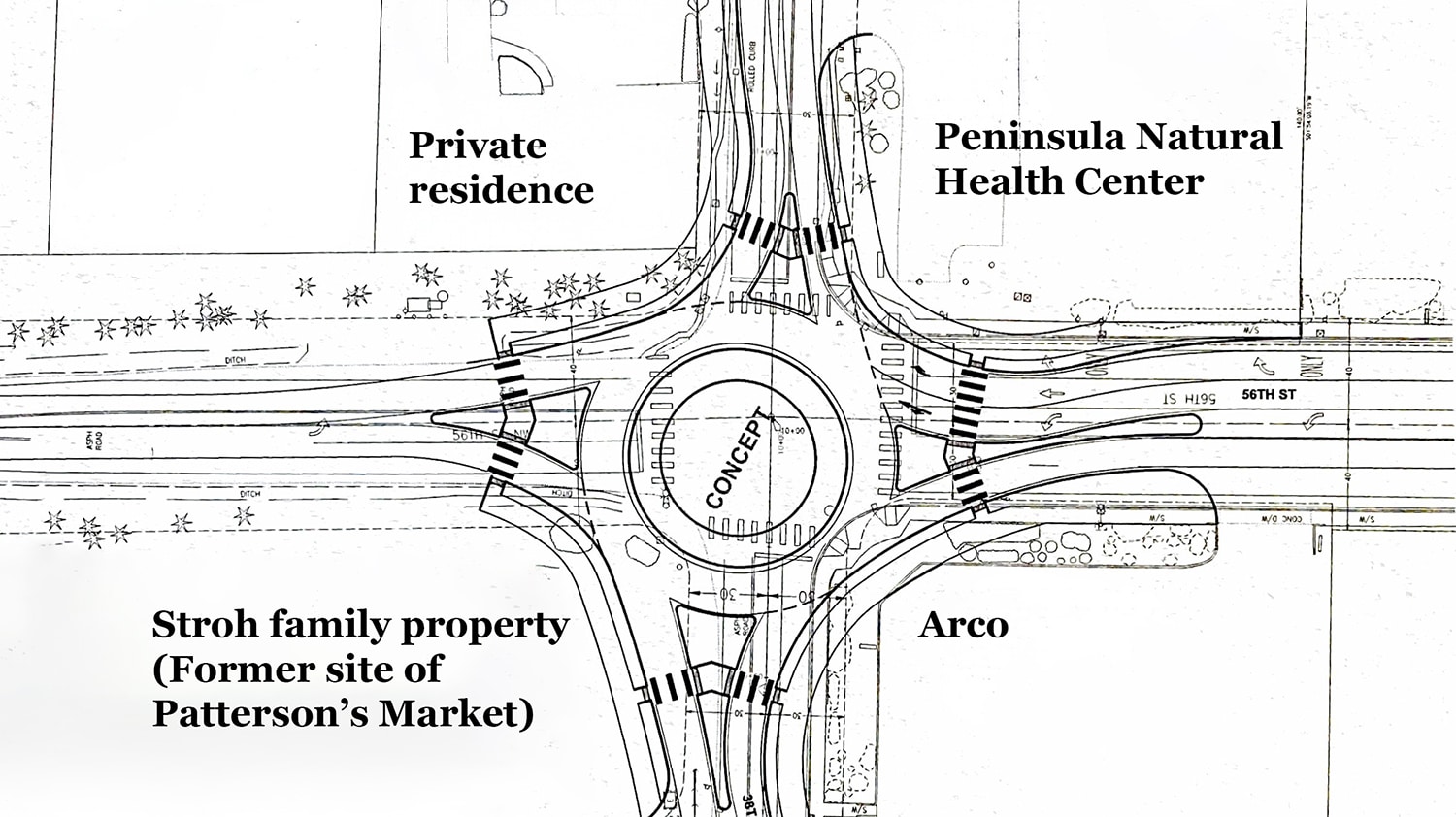
The roundabout could directly affect these four properties.
Intersection not ‘failed’ — yet
Owners of a residence at the northwest corner of 56th and 38th, and of the ARCO station at the southeast corner, also likely have to provide right-of-way for the roundabout. They could not be reached for comment.
The city of Gig Harbor defines a “failed” intersection as one at which vehicles experience a delay of longer than 55 seconds, on average. The city hired consultants Transportation Solutions to study the intersection of 56th Street and 38th Avenue. They found cars transiting the junction today experience an acceptable 25-second delay at peak hours.
However, given expected annual growth, by 2044 the mean wait at a signaled intersection there, similar to the existing one, would degrade to 60 seconds at peak times, the consultants found. Some drivers would wait even longer — southbound drivers turning left could expect to be stuck at the crossroads for more than two minutes.
In contrast, the proposed roundabout — with single-lane approaches and exits on the north, south, and west legs, and an east leg with one right-turn lane and one shared through-left lane — would slash average peak-hour delay time in 2044 to 9.1 seconds, the consultants found. In 2044 with the roundabout, even the worst-faring drivers (those traveling southbound at peak times) would wait an average of 22.6 seconds. That is less delay than drivers typically experience in the intersection today.
Downstream congestion?
The roundabout’s opponents are skeptical of the studies. In addition to preventing local residents from turning onto the arterials during busy times, the proposed roundabout would also likely cause significant congestion at downstream intersections, Matt Cyr said.
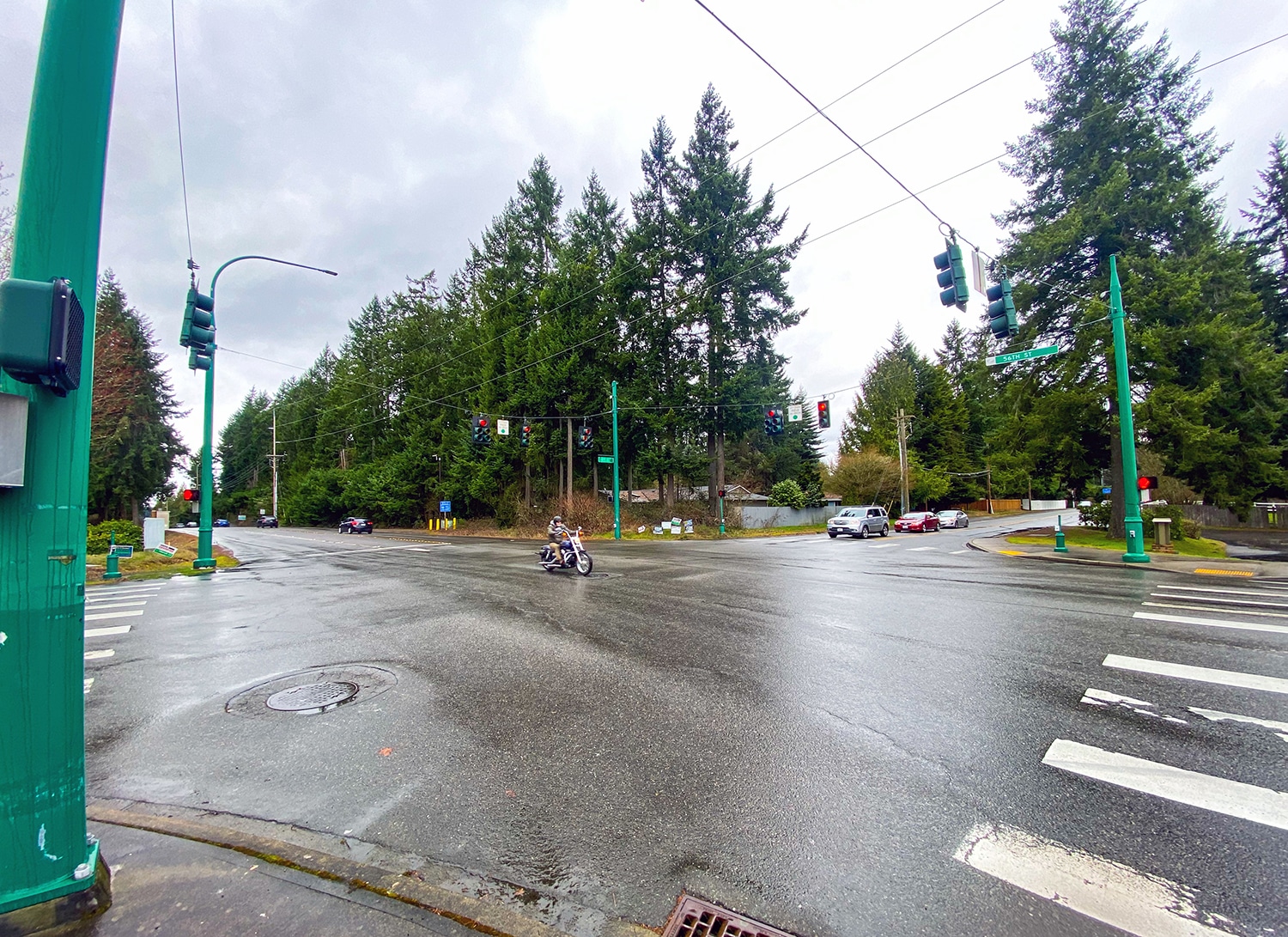
The intersection of 56th Street NW and 38th Avenue NW. Photo by Ted Kenney
“A signal at 38th and 56th provides traffic metering, similar to freeway on-ramp metering. Without metered traffic flow at 38th and 56th, downstream intersections such as Hunt and Wollochet Drive, or Olympic Drive and Point Fosdick Drive, may experience failure from the flood of traffic,” Cyr said.
In an e-mail, Hulst, the city’s traffic engineer, said that while roundabouts function differently than traffic signals, the city didn’t expect downstream intersections to be substantively impacted by the 38th/56th roundabout. If the city needs to adjust timing on these intersections’ traffic signals after building the roundabout, “that is an easy fix,” he said.
“Roundabouts provide natural gaps in downstream traffic flow as well, although, in a different manner than a traffic signal. This is something that is on our radar and being addressed and considered with the design of the roundabout,” he said.
Public process
The city does not plan public meetings or hearings devoted solely to the roundabout, Hulst said. But “we are updating the transportation element of the comprehensive plan right now and there are public meetings associated with that. General feedback on transportation projects can be given at those meetings,” he said.
In addition, “public input can also be given at any (city) council meeting. Ultimately, a construction contract will be presented to the council (and) this would be another time to provide public input,” Hulst said.
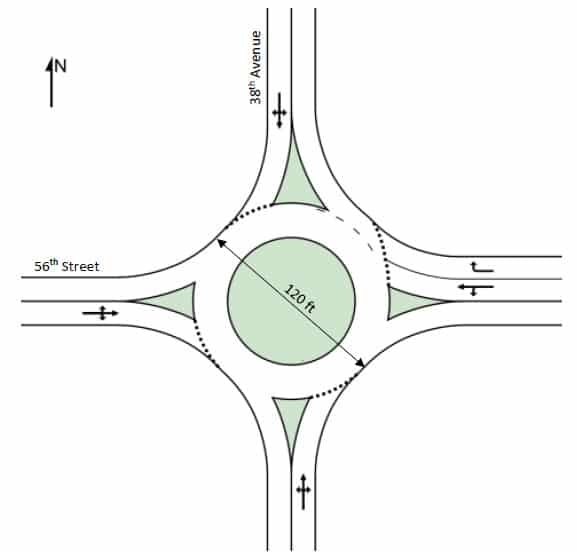
The size and lane layout of a possible roundabout at the intersection of 56th Street and 38th Avenue.
The city’s right-of-way consultants (sub-consultants to KPFF, the engineering firm designing the 38th Avenue improvements, including the roundabout) “will reach out to the affected landowners when we know the exact footprint(s) of the right-of-way” needed, Hulst said.
“Since we only have a concept level design, we do not yet know our right-of-way needs. Therefore, I cannot give you an exact date, but would guess that it would occur sometime later this year,” he said.
If the project moves forward as planned, groundbreaking on the roundabout will occur in spring 2025, Hulst said. Hulst said the 38th Avenue improvements, including the roundabout, would likely require “a full summer construction season” that year. Some private utility company work at the intersection will begin in 2024.
When the work begins, expect traffic delays. “It would be difficult to close this intersection for any substantive time frame, given the intersection volumes,” Hulst said. “These decisions will be made as design progresses. Full closures of the intersection will be limited in nature,” possibly including night work or short-duration closures, he said.
